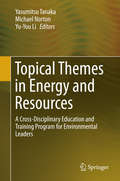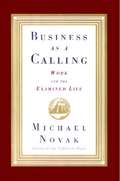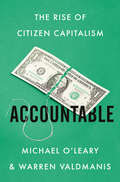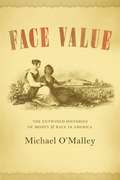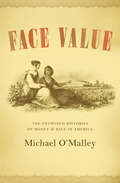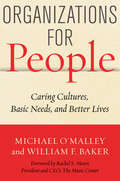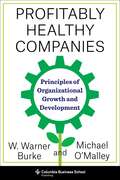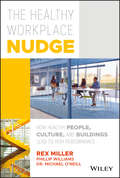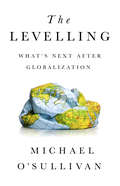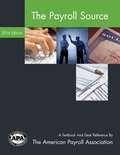- Table View
- List View
1worker1vote: MONDRAGON in the US
by Rebecca Henderson Michael NorrisMONDRAGON, the largest cooperative in the world, and the inspiration for several U.S. cooperatives, faces a challenge in 2013 after one of its largest cooperatives votes to leave the group and another goes bankrupt.
1worker1vote: MONDRAGON in the US
by Michael Norris Rebecca M. HendersonMONDRAGON, the largest cooperative in the world, and the inspiration for several U.S. cooperatives, faces a challenge in 2013 after one of its largest cooperatives votes to leave the group and another goes bankrupt.
Bank of America: Mobile Banking (Abridged)
by Michael Norris Sunil GuptaIn January 2010, Bank of America is discussing their future mobile strategy. Should the company add complexity to their app, design multiple apps for business segments, or expand into other mobile channels?
Bloodbuy
by Michael Norris Richard G. HamermeshIn 2015, Chris Godfrey, founder and CEO of Bloodbuy has to consider the best path to growth for his young company that is attempting to disrupt the blood donation industry.
Building a Social Media Culture at Dell
by Michael Norris Rohit DeshpandeAs Michael Dell refocused his newly-private company on services and solutions, the entire corporation was pushed to embrace social media.
Ken Traub at American Bank Note Holographics
by Michael Norris Suraj SrinivasanKen Traub is hired as CFO for American Bank Note Holographics, the market-leading security holograph company in January 1999, but discovers on his first day that the company has misstated its financials and resigns. After consulting with the company for the next several weeks as it announces its misstatements to the public, he is asked to become president of the company. Should he take the job or is the company a sinking ship?
MINTing Innovation at NewYork-Presbyterian (B)
by Michael Norris Richard G. HamermeshThis short (B) case gives an update on the progess that MINT has made at NYP since the end of the (A) case.
Streaming Over Broadband: Why Doesn't My Netflix Work?
by Shane Greenstein Michael NorrisIn late 2013 and early 2014, Netflix service over the major U.S. Internet Service Providers (ISPs) suffered major slowdowns. What were the causes of these problems? What could Netflix do to solve them?
Streaming Over Broadband: Why Doesn't My Netflix Work?
by Shane Greenstein Michael NorrisIn late 2013 and early 2014, Netflix service over the major U.S. Internet Service Providers (ISPs) suffered major slowdowns. What were the causes of these problems? What could Netflix do to solve them?
The I-PASS Patient Handoff Program
by Robert S. Huckman Michael NorrisIn 2015, the I-PASS Patient Handoff Program Team, led by six pediatricians around the U.S., had to determine the best way to disseminate their program that had been proven to reduce communication errors in patient handoffs in hospital settings. Should they turn it into a standalone business, continue publishing in academic journals, license their content to an established medical vendor, or do some combination of these? This case allows students to develop and evaluate approaches to disseminating simple and proven innovations with complex service settings.
U.S. Digital Service
by Michael Norris Mitchell Weiss Nick SinaiMikey Dickerson and Haley Van Dyck found themselves far from home and far from certainty about where to take the U.S. Digital Service (USDS) next. In the summer of 2015, they had landed in London to meet with Mike Bracken, director of the United Kingdom's Government Digital Service (GDS). In 2014, President Barack Obama had given USDS a monumental task: transform how the federal government worked for the American people, digitally. The seeds of USDS had grown out of the rescue of HealthCare.gov, the federal website meant to allow consumers to shop for private health insurance. Its launch and crash in October 2013 had threatened one of Obama's signature policy achievements. Dickerson and a small team had been drafted to help fix HealthCare.gov and had successfully done so in a matter of months. While in London, Dickerson and Van Dyck wondered, of the other areas that most cried out for new technology approaches, which should be tackled next? Moreover, GDS had embedded satellite teams into the U.K.'s government agencies to guide, assist, and in some cases control, each agency's digital presence. Did London hold lessons for if, and how, these teams could be successful in the U.S. government? USDS had begun to experiment with this model too, embedding teams in a handful of departments in the U.S federal government. How could USDS best work with the dozens of agencies that were actually doing the work of government?
U.S. Digital Service
by Michael Norris Nick Sinai Mitchell B. WeissMikey Dickerson and Haley Van Dyck found themselves far from home and far from certainty about where to take the U.S. Digital Service (USDS) next. In the summer of 2015, they had landed in London to meet with Mike Bracken, director of the United Kingdom's Government Digital Service (GDS). In 2014, President Barack Obama had given USDS a monumental task: transform how the federal government worked for the American people, digitally. The seeds of USDS had grown out of the rescue of HealthCare.gov, the federal website meant to allow consumers to shop for private health insurance. Its launch and crash in October 2013 had threatened one of Obama's signature policy achievements. Dickerson and a small team had been drafted to help fix HealthCare.gov and had successfully done so in a matter of months. While in London, Dickerson and Van Dyck wondered, of the other areas that most cried out for new technology approaches, which should be tackled next? Moreover, GDS had embedded satellite teams into the U.K.'s government agencies to guide, assist, and in some cases control, each agency's digital presence. Did London hold lessons for if, and how, these teams could be successful in the U.S. government? USDS had begun to experiment with this model too, embedding teams in a handful of departments in the U.S federal government. How could USDS best work with the dozens of agencies that were actually doing the work of government?
Weathering the Storm at NYU Langone Medical Center
by Robert S. Huckman Michael Norris Rafaella SadunIn the fall of 2012, Hurricane Sandy forced a full evacuation of NYU Langone Medical Center in New York City. The institution, which comprised NYU Medical School and several teaching hospitals, had been on an upward trajectory for several years under the leadership of Dr. Robert I. Grossman. Grossman's central initiative, which he credited with helping to create a performance-driven, transparency-focused culture was an information technology dashboard system that provided managers and front line workers with a wealth of real-time information. Would the disruption posed by the hurricane throw NYU Langone off track?
Weathering the Storm at NYU Langone Medical Center
by Robert S. Huckman Michael Norris Raffaella SadunIn the fall of 2012, Hurricane Sandy forced a full evacuation of NYU Langone Medical Center in New York City. The institution, which comprises NYU Medical School and several teaching hospitals, had been on an upward trajectory for several years under the leadership of Dr. Robert I. Grossman. Grossman's central initiative, which he credited with helping to create a performance-driven, transparency-focused culture was an information technology dashboard system that provided managers and front line workers with a wealth of real-time information. Would the disruption posed by the hurricane throw NYU Langone off track?
Sustainability: Duty or Opportunity for Business?
by Michael NortonBusinesses are expected to act sustainably; it is also in both societal and their interests if businesses seek and grasp opportunities to develop more sustainable products or services. Leading international companies may already be moving in this direction, but many (especially smaller companies) are often held back by a lack of personnel or know how. This book has been written to overcome this deficit by providing a convenient ‘one-stop-shop’ where readers (whether they be business staff, university or business school student) can understand personally what the sustainability issue is about, and appreciate the many areas where companies can respond to the challenge of a more sustainable world. Based on a successful ‘Green’ Management of Technology Masters introduced in Japan in 2008, this book explains in non-specialist language why current economic systems under which firms operate do not lead to sustainable outcomes, provides the background and evolution of concerns over sustainability and the many potential opportunities for businesses. It also provides sufficient understanding of key environmental and social issues to support informed debate, and encourages readers to consider working for a more sustainable organisation and society. The book provides an overview of the internal business issues raised by concerns over sustainability, and the many external opportunities which exist for innovation and development of new products and services, which can contribute to both company viability and a sustainable future for society. It can either be used as a basis for self-study and learning, or as a textbook to support a course in an MBA, MOT or similar business-oriented course. It includes educational feedback from the course students (mostly working in local businesses), which may encourage readers to explore the interactions between sustainability and business, and help teachers planning and implementing similar courses. It also blends together case studies from both UK and Japan providing a genuinely trans-national perspective.
Topical Themes in Energy and Resources
by Michael Norton Yasumitsu Tanaka Yu-You LiThis book combines issues several critical ones in the energy field (low-energy technologies, renewable energies such as the hydrogen economy, and geothermal energy). Moving towards a more sustainable world requires a complete revolution in the way we manage energy and resources. However, from an academic perspective, this theme is so broad that most educators and researchers tend to focus on just one aspect, and maintaining the broad viewpoint which is necessary for making strategic judgments becomes difficult. Tohoku University addressed this challenge when developing a new education and training program for environmental leaders and brought together the extensive range of expertise available in specific fields into one special course which forms the basis of this book. Now in one volume, both students and educators can be brought up to date on a wide range of critical issues currently being addressed in the field of energy and resources. Chapters on resources include availability (for instance, rare earth metals), extraction and recycling of metals and plastics, and technological solutions to specific waste-disposal problems. In addition, broader strategic issues such as limits to growth and the interaction between the economic system and environmental issues are addressed. Even though each chapter provides topical data and knowledge from disparate and specialized fields, the book is written at a level that is readily understandable by students from all scientific, engineering, and humanities fields.
Business as a Calling: Work and the Examined Life
by Michael NovakThis book is a spiritual feast, for everyone who wants to examine how to make a life through making a living.
Accountable: The Rise of Citizen Capitalism
by Michael O'Leary Warren Valdmanis“More than ever before, this is the book our economy needs.” – Dr. Rajiv Shah, president of the Rockefeller Foundation“Unwilling to settle for easy answers or superficial changes, O’Leary and Valdmanis push us all to ask more of our economic system.” – Senator Michael F. BennetThis provocative book takes us inside the fight to save capitalism from itself.Corporations are broken, reflecting no purpose deeper than profit. But the tools we are relying on to fix them—corporate social responsibility, divestment, impact investing, and government control—risk making our problems worse.With lively storytelling and careful analysis, O’Leary and Valdmanis cut through the tired dogma of current economic thinking to reveal a hopeful truth: If we can make our corporations accountable to a deeper purpose, we can make capitalism both prosperous and good.What happens when the sustainability-driven CEO of Unilever takes on the efficiency-obsessed Warren Buffett? Does Kellogg’s—a company founded to serve a healthy breakfast—have a sacred duty to sell sugary cereal if that’s what maximizes profit? For decades, government has tried to curb CEO pay but failed. Why? Can Harvard students force the university to divest from oil and gas? Does it even matter if they do?O’Leary and Valdmanis, two iconoclastic investors, take us on a fast-paced insider’s journey that will change the way we look at corporations. Likely to spark controversy among cynics and dreamers alike, this book is essential reading for anyone with a stake in reforming capitalism—which means all of us.
Face Value: The Entwined Histories of Money and Race in America
by Michael O'MalleyFrom colonial history to the present, Americans have passionately, even violently, debated the nature and the character of money. They have painted it and sung songs about it, organized political parties around it, and imprinted it with the name of God--all the while wondering: is money a symbol of the value of human work and creativity, or a symbol of some natural, intrinsic value? In Face Value, Michael O'Malley provides a deep history and a penetrating analysis of American thinking about money and the ways that this ambivalence unexpectedly intertwines with race. Like race, money is bound up in questions of identity and worth, each a kind of shorthand for the different values of two similar things. O'Malley illuminates how these two socially constructed hierarchies are deeply rooted in American anxieties about authenticity and difference. In this compelling work of cultural history, O'Malley interprets a stunning array of historical sources to evaluate the comingling of ideas about monetary value and social distinctions. More than just a history, Face Value offers us a new way of thinking about the present culture of coded racism, gold fetishism, and economic uncertainty.
Face Value: The Entwined Histories of Money and Race in America
by Michael O'MalleyThe cultural historian and author of Keep Watching analyses American ideas about race, money, identity, and their surprising connections through history. From colonial history to the present, Americans have passionately, even violently, debated the nature and of money. Is it a symbol of the value of human work and creativity, or a symbol of some natural, intrinsic value? In Face Value, Michael O&’Malley provides a penetrating historical analysis of American thinking about money and the ways that this ambivalence intertwines with race. Like race, money is bound up in questions of identity and worth, each a kind of shorthand for the different values of two similar things. O&’Malley illuminates how these two socially constructed hierarchies are deeply rooted in American anxieties about authenticity and difference. In this compelling work of cultural history, O&’Malley interprets a wide array of historical sources to evaluate competing ideas about monetary value and social distinctions. More than just a history, Face Value offers a new way of thinking about the present culture of coded racism, gold fetishism, and economic uncertainty. &“This is a &‘big idea&’ book that no one but Michael O&’Malley could even have thought of—much less pulled off with such nuance and clarity.&”—Scott A. Sandage, author of Born Losers
Organizations for People: Caring Cultures, Basic Needs, and Better Lives
by Michael O'Malley William F. BakerFor many years, there has been quite a bit of talk about employee engagement as a means to lift corporate profits and reduce absenteeism and turnover. However, this talk has not produced better companies. In fact, the evidence shows that incivility and instances of employee abuse are getting worse. Additionally, with profit as the primary goal of organizations, most employees view any benign treatment they receive as a secondary convenience that will dissipate once corporate fortunes decline. That is, many employees still believe they are expendable in the eyes of their employers. This book turns that equation around by examining the practices of twenty-one companies that put the interests and needs of employees first. Profits are necessary but insufficient for corporate health. The companies featured in this book see it as their mission to offer people a better, more fulfilling life for themselves, and assist with that holistic journey by providing the organizational elements people need to reach their potential. They do this first by creating respectful and kind cultures that treat every person as an equal, sentient partner in the success of the company. Second, they diligently work to satisfy people's basic needs: financial security, belonging, meaning, autonomy, self-acceptance, self-confidence, and growth. The result is a web of fellow-feeling: earnest affection among people who feverishly work to live up to both the high standards of the institution and their obligations to one another. By providing a place where people can do their best work and thrive as individuals and as members of a cohesive community, everyone profits.
Profitably Healthy Companies: Principles of Organizational Growth and Development
by Michael O'Malley Warner BurkeEvery company faces challenges, but some are able to achieve long-term vitality while others flame out. What distinguishes a healthy, high-performing organization? Which ingredients, decisions, and values result in a business that is built for the long haul?Profitably Healthy Companies lays out ten essential principles of organizational development for sustained success. Bringing together practical and academic expertise, W. Warner Burke and Michael O’Malley detail proven methods for every organization at each level. They demonstrate why a focus on employee and community well-being is more likely to ensure lasting profitability than a single-minded focus on the bottom line. Burke and O’Malley explain the keys to company resilience, examining safeguards against decline and disaster as well as tools for generative renewal and growth. They show how organizational culture encourages optimal performance, flexible and adaptive corporate strategy, and employee motivation and commitment. The book emphasizes up-to-the-moment issues, such as how to center diversity and inclusion and the promise and pitfalls of remote work.Burke and O’Malley base their recommendations on research in organizational psychology as well as their own extensive consultative experience, providing a rich array of case studies and examples. Profitably Healthy Companies is a clear and authoritative guide for practitioners, leaders, and decision makers, synthesizing an all-inclusive treatment of organizational life with a comprehensive checklist of what organizations must do in order to thrive.
The Healthy Workplace Nudge: How Healthy People, Culture, and Buildings Lead to High Performance
by Michael O'Neill Rex Miller Phillip WilliamsDiscover how healthy buildings, culture, and people lead to high profits Organizations and employees now spend an average of $18,000 per year per employee for health costs, a 61% increase in 10 years. Every indicator projects these costs will double before 2030. This is an unsustainable path. These costs are the tip to an even bigger iceberg, the hidden costs of time out of the office, distraction, disengagement, and turnover. The Healthy Workplace Nudge explains the findings of research on 100 large organizations that have tackled the problems of employee health costs and disengagement in five fresh ways: Well-being leads to health and high performance Wake up to the fact that 95% of traditional wellness programs fail to improve health or lower costs Behavioral economics has become a new powerful tool to nudge healthy behavior Healthy buildings are now cost effective and produce your strongest ROI to improving health Leaders who develop healthy cultures achieve sustainable high performance and employee wellbeing In addition to proving highly effective, these approaches represent a fraction of the cost sunk into traditional wellness and engagement programs. The book explains how to create a workplace that is good for people, releases them to what they do best and enjoy most, and produces great and profitable work. • Find actionable strategies and tactics you can put into use today • Retain happy, productive talent • Cut unnecessary spending and boost your bottom line • Benefit from real-world research and proven practice If you’re a leader who cares about the health and happiness of your employees, a human resource professional, or a professional who develops, designs, builds, or outfits workplace environments to improve employee health and wellbeing, this is one book you’ll want to have on hand.
The Levelling: What's Next After Globalization
by Michael O'SullivanA brilliant analysis of the transition in world economics, finance, and power as the era of globalization ends and gives way to new power centers and institutions. The world is at a turning point similar to the fall of communism. Then, many focused on the collapse itself, and failed to see that a bigger trend, globalization, was about to take hold. The benefits of globalization--through the freer flow of money, people, ideas, and trade--have been many. But rather than a world that is flat, what has emerged is one of jagged peaks and rough, deep valleys characterized by wealth inequality, indebtedness, political recession, and imbalances across the world's economies. These peaks and valleys are undergoing what Michael O'Sullivan calls "the levelling"--a major transition in world economics, finance, and power. What's next is a levelling-out of wealth between poor and rich countries, of power between nations and regions, of political accountability from elites to the people, and of institutional power away from central banks and defunct twentieth-century institutions such as the WTO and the IMF.O'Sullivan then moves to ways we can develop new, pragmatic solutions to such critical problems as political discontent, stunted economic growth, the productive functioning of finance, and political-economic structures that serve broader needs.The Levelling comes at a crucial time in the rise and fall of nations. It has special importance for the US as its place in the world undergoes radical change--the ebbing of influence, profound questions over its economic model, societal decay, and the turmoil of public life.
The Payroll Source
by Michael O'TooleThe Payroll Source® provides the essential information you need to keep your company in compliance with federal laws and regulations affecting your payroll operations. Comprehensive and clearly written by a leading payroll expert, this revolutionary book eliminates the need to refer to multiple sources seeking answers to your payroll questions. It details all aspects of payroll administration, from the most fundamental forms and regulations, through the most complex benefits taxation and reporting, to international payrolls. Comprehensive updates to the text occur each year. The Payroll Source is a proven study tool to prepare for the Certified Payroll Professional (CPP) exam.


